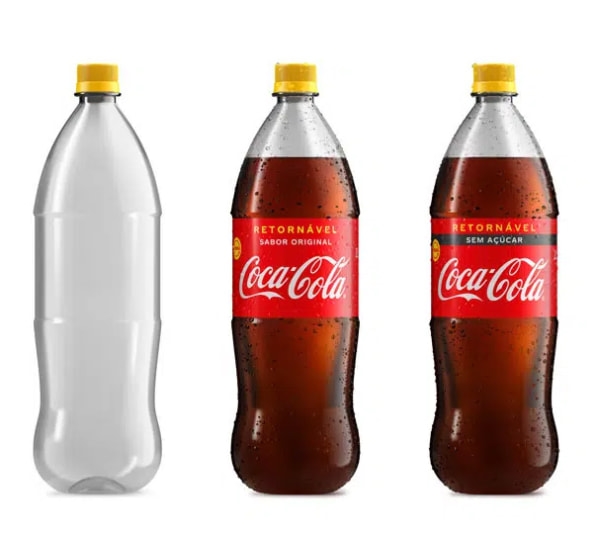If you buy a bottle of Coke or Fanta in Brazil, it might come in a “universal bottle.” Ideally you’d take that reusable plastic bottle, designed to be used by multiple Coca-Cola brands, and return it to the store. When a delivery driver comes to the store with a new shipment, they’ll take the old bottles to a bottling facility to be cleaned, refilled, and relabeled. Customers get a discount each time they bring the bottles back, an incentive that means the bottles are reused an average of 25 times. In 2019, the year after Coca-Cola launched the program in Brazil, the company produced 1.8 billion fewer bottles.
Coca-Cola recently announced that by the end of the decade, it will sell a quarter of its drinks in refillable packaging. It hasn’t yet shared the details about where it plans to focus its efforts; as of now, while refillable glass or plastic bottles are commonly used in some countries, they represent a tiny fraction of sales in a place like the U.S. (Coca-Cola told Fast Company that it wants to allow flexibility in how local markets contribute to the global goal.) But before single-use plastic bottles became ubiquitous, refillable soda bottles were the norm. What would it take to return to a system that dramatically shrinks waste?

[Photo: The Coca-Cola Co.]
Even a small shift to refillable packaging can have an outsize impact. Oceana, an environmental nonprofit, calculated that as many as 34 billion plastic bottles may reach the ocean each year. If the percentage of refillable bottles grew just 10% in coastal countries, it would reduce ocean plastic pollution from PET bottles by 22%, the nonprofit found. “Reusables are a very leveraged way to reduce plastic pollution on the ocean,” says Matt Littlejohn, senior vice president of strategic initiatives at Oceana.
Recycling alone can’t solve the problem of plastic waste. In the U.S., less than a third of plastic drink bottles get recycled. In Brazil, around 90% of Coke’s refillable bottles are taken back to the store; the company wants the bottles back, so it does everything it can to get customers to comply. “In a reusable system like Coke has, they own bottles as inventory,” Littlejohn says. “They’re actually assets on their books.”
While bottle deposit fees and other policy changes could help improve recycling rates, reusable bottles have a second advantage of using far less material, shrinking the environmental footprint of the packaging. Even glass bottles, which use more energy than plastic to produce and transport, can have a lower carbon footprint than single-use plastic bottles when the glass bottles are repeatedly reused.
Reusable glass bottles used to be the standard for soda packaging, and Oceana believes that they’re still the best option now. Glass bottles are reused an average of 50 times in refill systems and then melted down and remade into new glass bottles. Reusable plastic bottles still have challenges, especially if they’re made from fossil fuels rather than recycled plastic. But Littlejohn says that refillable plastic bottles are still a viable option since they can also steeply reduce waste. “The main thing is not to pollute the oceans,” he says.
The basic system of refillable packaging isn’t complex, though companies do have to invest in the infrastructure to clean and repackage bottles and track them in reverse logistics. But it’s easiest for companies to start in places where refillable packaging is already widespread, like Latin America, or Germany, where the law requires that a certain percentage of bottles get reused.
In the U.S., there are likely to be challenges from grocery stores that don’t want to devote space or time to managing old bottles. “They don’t want the hassle,” says Conrad MacKerron, senior vice president at As You Sow, a nonprofit that had filed a shareholder proposal asking Coca-Cola to set stronger goals for reusables. “This makes it difficult for consumers who want their deposit to return bottles to where they purchased them.” (In Brazil, Coca-Cola offers customers a digital wallet system that tracks bottle purchases so that they can be returned to different stores to try to make the process more convenient.)
Refillable packaging is slowly catching on in the U.S., including through projects like Terracycle’s Loop, which is now selling mainstream products in reusable packaging at some Kroger stores. Coca-Cola is working with Loop to test reusable cups for soda machines at Burger King; in France, it’s working with a grocery chain and Loop to sell drinks in refillable bottles. The company is also beginning to employ reusable cups with microchips at its Freestyle soda machines at universities and theme parks, and beginning to pilot more refillable and returnable bottle programs in the U.S.
Oceana says that new policies could help the process move faster, and help other companies make the change; Coca-Cola is furthest ahead with its goal on reusable packaging (it’s also been the top plastic polluter four years in a row). Policies like mandatory container deposits could help, as well as “green fees” on single-use bottles, quotas on refillable bottles, and requirements for standardized bottles. Or, governments could take the final step of banning single-use containers.
Fast Company , Read Full Story
(114)